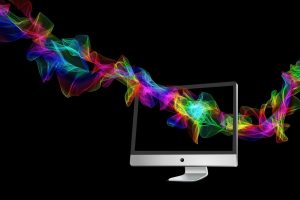Find out why these new releases are causing such excitement and what benefits they offer to those who are already fans of the Apple ecosystem.
A strange thing occurred at CES this year: display makers other than Apple introduced real 5K and 6K monitors made for productivity and creative work. These new monitors offer some real competition to Apple’s Studio Display and even an option to the absurdly costly pro-level Pro Display XDR, which will appeal to Mac users for reasons other than it’s white and doesn’t have RGB lights.
MacBook connectivity

One cannot emphasize enough how uncommon this is. Although there have been numerous monitors marketed toward MacBook owners over the years with features like USB-C connectivity, high-wattage charging, and nicer-than-average designs, they have typically all had conventional 4K panels and subpar pixel densities, as opposed to the higher-resolution displays that Apple uses in its devices. If you connected a MacBook to one of those other monitors, a compromise was always necessary.
MacOS’s display
 Many people are perplexed as to why, with the abundance of options, you can’t simply utilize a huge 4K monitor with a Mac. Pixel resolution and brightness are more crucial features than swift refresh rates and response times, which are often included in monitors targeted at PC gamers, because of how display scaling functions in macOS.
Many people are perplexed as to why, with the abundance of options, you can’t simply utilize a huge 4K monitor with a Mac. Pixel resolution and brightness are more crucial features than swift refresh rates and response times, which are often included in monitors targeted at PC gamers, because of how display scaling functions in macOS.
MacOS’s display scaling algorithm necessitates more pixels than a standard 4K monitor can provide. The very short explanation is that for the highest level of fidelity, you need a screen with at least 220 pixels per inch (ppi). In other words, 4K resolutions (3840 x 2160 pixels) are limited to 24 inches; 27-inch screens require 5K (5120 x 2880 pixels); and anything larger than 30 inches requires 6K (6016 x 3384 pixels).
Apple’s Monitors display

In order to create a line of monitors that did match the pixel density of its MacBook Pros, Apple, which had exited the monitor market a few years earlier, collaborated with LG in 2016. The line included a 22-inch 4K display, a 24-inch 4K model, and—most intriguingly—a 27-inch 5K standalone monitor that essentially shared the same screen as the 5K iMac. In addition to allowing a single USB-C cable connection, brightness and volume adjustments from the MacBook’s keyboard, and having an integrated camera, microphone, and speakers, these LG UltraFine displays worked well with Apple’s laptops at the time. The display panels looked fantastic, especially the 5K model, with clear images and excellent color reproduction. However, they had a number of problems, including a subpar build, low dependability, and high costs.
The Studio Display, a 27-inch 5K examiner, was Apple’s response to calls for a more accessible monitor in 2021. It employed the same display technology and panel as the Studio Display( albeit with slightly advanced brilliance) as the LG 5K UltraFine and 27-inch iMac, wrapped it in a glossy aluminum frame, and bettered its in-built microphones and speakers( but sorely, loaded it with a worse webcam). The $1,600 Studio Display is more affordable than the Pro Display XDR, but it’s far from cheap and feels small in this world of numerous bigger options. But if you wanted pixel-perfect resolution from your Mac, it’s principally the only realistic option.
Samsung Monitors for Mac users 
The new Samsung screens for Mac users aren’t just standard 4K panels with USB-C connectors and white plastic; instead, they have high-res pixel densities that are ideal for macOS and match the crispness of Apple’s displays. Additionally, they provide a complete desk arrangement with a single connection, offering the same “whole package” that Apple provides with the Studio Display, which includes an integrated webcam, microphone, and speakers.
A 27-inch 5K display from Samsung that competes head-to-head with Apple’s Studio Display is the ViewFinity S9. It features Thunderbolt 4 for connectivity, matches the brightness and color space accuracy, and has the same 5120 x 2880 resolution. Additionally, it has built-in speakers and microphones and should include a webcam that performs better.
With more connectivity choices, such as HDMI and DisplayPort, Samsung surpasses Apple and makes it far more useful for usage with two PCs or a gaming console. Even the remote is included, and it has Samsung’s smart TV software installed so you can use it to watch streaming services after work or throughout the day. You can click here to buy one for yourself.
Additionally, we are unsure of how well these displays will function in actual use. We had positive impressions of the S9 during our little time with it this week, but that was far from using it in a real-world setting. We’re not precisely sure how well Samsung’s 4K cameras operate or how much better the microphones and speakers—both of which are Certifiably Good on the Studio Display—perform.
Samsung vs. Apple monitors

Regarding their level of compatibility with Apple’s accessories, there are still unanswered questions. With these monitors, you’ll probably have to give up Apple-specific features like True Tone, and if you’re using a MacBook Pro 14 or 16, you won’t receive the ProMotion smoothness or brightness pop that comes with the Mini LED panels on those laptops.
Nevertheless, it’s beautiful because, after so many years of either average or expensive (or both) options, we’re now beginning to see real options for high-resolution displays that are made to maximize macOS. According to rumors, Apple is also developing up to three new monitors, some of which may employ the same Mini LED technology as the MacBook Pro screens.
It’ll be a good year if you’re looking for a new MacBook or Mac Studio monitor.


Leave a Reply